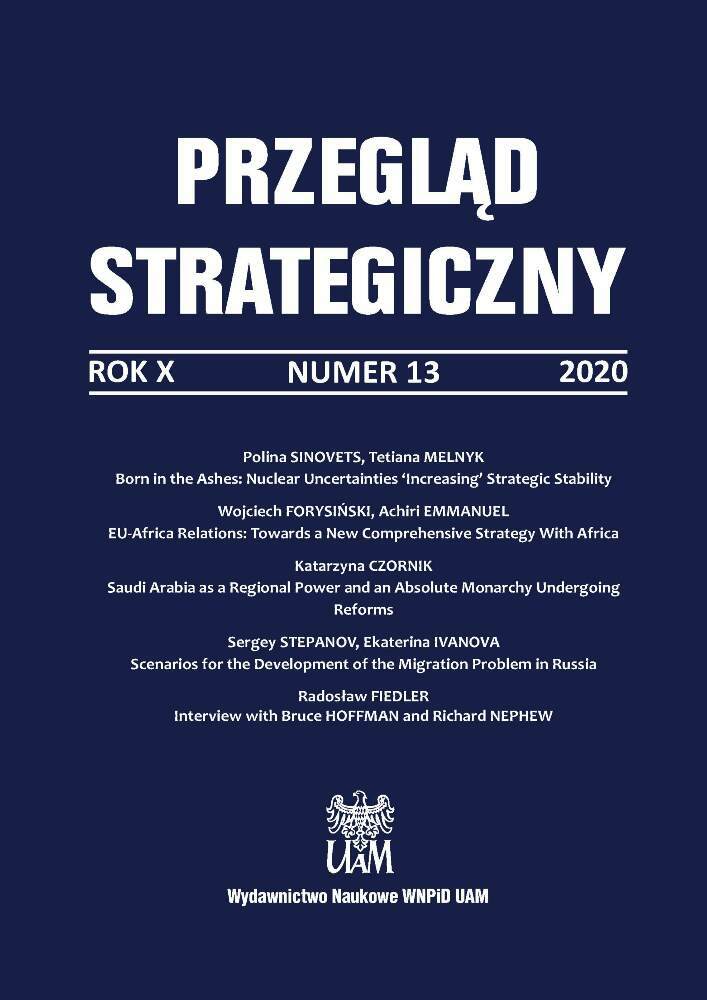Abstract
The paper is devoted to an analysis of the institutional mechanisms that ensure national security in the information space of several leading countries – the United States, the United Kingdom and the Russian Federation. It is stated that institutional mechanisms that ensure national security in the information space of the leading countries all have a similar structure. The main components of these mechanisms involve public authorities (state leaders – president or prime minister, government, ministries, and agencies), local government bodies, civil society institutions, the academic community, business community, and the media. The gradual expansion of the system of institutions that ensure national security in the information space and increase in their powers occurs in all these states. The analysis also demonstrates the paradigm shifts in the development and implementation of US and UK information policy in the context of modern nonlinear processes. Paradigmatic shifts are currently being reoriented towards the interests and needs of target audiences, diversification of channels and mechanisms of the distribution of meaning (strategic narratives) in the information space, from vertical to horizontal interaction with internal and external audiences. Emphases are shifting to the involvement of a wide range of institutions and other stakeholders in the implementation of information policy and delegation of powers from the center to the periphery, while preserving the main parameters of the policy established by state structures.
References
About us. Departments (Directorates–General) and services. Communication, European Commission, http://ec.europa.eu/dgs/communication/about/index_en.htm (22.03.2015).
Action plan to improve communicating Europe by the Commission, EUR-Lex, http://europa.eu/legislation_summaries/institutional_affairs/decisionmaking_process/l10102_en.htm (22.03.2015).
Annual Report (2015), Annual Report for the period from 1 January 2015 to 31 December 2015, NATO Strategic Communications Centre of Excellence, https://www.stratcomcoe.org/download/file/fid/5462 (28.05.2016).
Barovska A. V. (2015), Strategichni kommunikacii: dosvid NATO, „Strategichni prioriteti”, No. 1.
Baudrillard J. (2010), Simulacra and simulation, Univ. of Michigan Press, Ann Arbor, Mich.
Bondarenko S., Nagornyak T., Polovyi M. (2018), Modern information models of the national interests’ protection policy of the world countries, „European journal of transformation studies”, Vol. 6, Iss. 2.
Committee on Public Diplomacy (CPD), NATO, http://www.nato.int/cps/en/natohq/topics_69272.html (29.08.2019).
Communication Policy & Strategy, European Commission, http://ec.europa.eu/ipg/basics/policy/index_en.htm (19.03.2016).
Communications and public diplomacy, NATO, http://www.nato.int/cps/en/natohq/topics_69275.htm (27.07.2016).
Country Team, U.S. Department of States, http://www.state.gov/courses/rs401/page_25.htm (14.12.2014).
Danylenko S. Y. (2015), Mentalʹno-kulʹturnye y polytycheskye posledstvyya ynformatsyonnoy ahressyy Rossyy protyv Ukrayny y puty ee preodolenyya, „Problemy mizhnarodnykh vidnosyn”, Iss. 10–11, http://nbuv.gov.ua/UJRN/Pmv_2015_10-11_24 (25.05.2017).
Deutsch K. W. (1975), The nerves of government: models of political communication and control, 5th pr. [of the rev. ed.], New York.
Doktrina informatsionnoy bezopasnosti (2000), Doktrina informatsionnoy bezopasnosti Rossiyskoy Federatsii, 9 sentyabrya 2000 g. No. PR-1895, Femida.info, http://www.femida.info/14/19002.htm (22.03.2015).
EU in the World, European External Action Service, https://eeas.europa.eu/headquarters/headquarters-homepage/area/geo_en (02.08.2019).
EU Local offices and information points, European Commission, http://ec.europa.eu/contact/local_offices_en.htm (12.01.2019).
Fuerth L. (2011), Operationalizing Anticipatory Governance, „Prism”, Vol. 2, No. 4, http://cco.ndu.edu/Portals/96/Documents/prism/prism_2–4/Prism_31-46_Fuerth.pdf (22.03.2015).
Government Communications Plan 2016/17, Government Communication Service, https://gcs.civilservice.gov.uk/wp-content/uploads/2017/08/6.3149_CO_GCS-Comms-Plan_FINAL_WEB.pdf (12.09.2017).
Horbulin V. P., Kachynsʹkyy A. B. (2010), Stratehichne planuvannya: vyrishennya problem natsionalʹnoyi bezpeky, Kyyiv.
Hubersʹkyy L. V., Kaminsʹkyy Y. Y., Makarenko Y. A., Ozhevan M. A., Shnyrkov O. I. (2007), Informatsiyna polityka Ukrayiny: yevropeysʹkyy kontekst, Kyyiv.
Improving GCS, Government Communication Service, https://gcs.civilservice.gov.uk/about-us/improving-gcs/ (11.04.2019).
Improving government communications: GCS 2020, https://gcs.civilservice.gov.uk/about-us/gcs-2020/ (17.01.2020).
Khabermas Y. (2007), Teoriya kommunikativnogo deystviya (Fragmenty), „Voprosy sotsial’noy teorii”, Vol. 1, Iss. 1.
Komarova Y. U. (2005), Deyakí aspekti analízu strukturnoí̈ samoorganízatsíí̈ polítichnoí̈ sistemi, „Polítichniy menedzhment”, No. 1.
Kontseptsiya vneshney politiki (2016), Kontseptsiya vneshney politiki Rossiyskoy Federatsii, 30 noyabrya 2016, Ministerstvo inostrannykh del Rossiyskoy Federatsii, http://www.mid.ru/foreign_policy/news/-/asset_publisher/cKNonkJE02Bw/content/id/2542248 (15.12.2019).
Lipkan V. A. (2006), Teoretychni osnovy ta elementy natsionalʹnoyi bezpeky Ukrayiny, Kyyiv.
Mahda Y. E. (2017), Hibrydna ahresiya Rosiyi: uroky dlya Yevropy, Kyyiv.
MIP: Dosvid Uryadu Velykobrytaniyi bude vykorystano pid chas reformy systemy derzhavnykh komunikatsiy (2015), Ministerstvo informatsiynoyi polityky Ukrayiny, 21 hrudnya, http://mip.gov.ua/news/866.html (17.10.2016).
Morgenthau G. (2000), Politicheskiye otnosheniya mezhdu natsiyami. Bor’ba za vlast’ i mir, in: Politologiya: khrestomatiya, (eds.) M. A. Vasilik, Moskva.
Moskalʹova N. (2016), Kontseptsiyi natsionalʹnoho interesu v naukoviy literaturi, „Visnyk Donetsʹkoho natsionalʹnoho universytetu. Seriya politychni nauky”, No. 1, http://jvestnik-politology.donnu.edu.ua/article/view/3931/3964 (17.10.2016).
Nahornyak T. L. (2013), Brendynh terytoriy yak derzhavna ta rehionalʹna polityka, Donetsʹk.
National framework for strategic communication, Federation of American Scientists, http://www.fas.org/man/eprint/pubdip.pdf (15.07.2015).
Ob Upravlenii (2012), Ob Upravlenii Prezidenta Rossiyskoy Federatsii po obshchestvennym svyazyam i kommunikatsiyam, Ukaz Prezidenta Rossiyskoy Federatsii No. 876, http://www.kremlin.ru/ref_notes/1242 (16.07.2019).
Pocheptsov H. (2016), Smysly i viyny: Ukrayina i Rosiya v informatsiyniy i smysloviy viynakh, Kyyiv.
Polovyi M. A. (2011), Politichni procesi: teorija ta praktika modeluvannja, Odesa.
Prorok V. (2016), Teoriya khaosa i teoriya setey – novyye podkhody k modelirovaniyu politicheskoy sistemy, „PolitBook”, Vol. 1.
Smola L. Y. (2016), Aspekty vedennya informatsiynoyi ta hibrydnoyi viyny v konteksti zastosuvannya komunikatsiynykh tekhnolohiy, „S.P.A.C.E. Society, Politics, Administration in Central Europe: elektronnyy naukovo-praktychnyy zhurnal”, Iss. 1.
Strategic Plan (2016), Strategic Plan 2016–2020 DG communication, European Commission, https://ec.europa.eu/info/sites/info/files/strategic-plan-2016-2020-dg-comm_april2016_en.pdf (25.08.2016).
Struktura Ministerstva, Ministerstvo tsifrovogo razvitiya, svyazi i massovykh kommunikatsiy Rossiyskoy Federatsii, https://digital.gov.ru/ru/ministry/structure/ (10.01.2020).
Struktura Pravitel’stva RF. Raspredeleniye obyazannostey v rukovodstve Apparata Pravitel’stva, Pravitel’stvo Rossii, http://government.ru/office/responsibilities/ (15.01.2020).
Taleb N. (2014), Antikhrupkost’. Kak izvlech’ vygodu iz khaosa, Moskva.
The Government Communication Service: an introduction, Government Communication Service, https://gcs.civilservice.gov.uk/wp-content/uploads/2015/08/About-the-Government-Communication-Service.pdf (13.08.2019).
Toffler E. (2009), Metamorfozy vlasti: Znaniye, bogatstvo i sila na poroge XXI veka, Moskva.
Tuathail Gearóid Ó. (1998), Postmodern geopolitics? The modern geopolitical imagination and beyond, in: Rethinking Geopolitics, (eds.) S. Dalby, G. O. Tuathail, London.
Turchenko O. H. (2013), Shchodo identyfikatsiyi katehoriy «interes» ta «natsionalʹnyy interes» yak ob’yektiv zabezpechennya bezpeky, „Pravnychyy chasopys Donetsʹkoho universytetu”, No. 1.
Tykhomyrova Y. B. (2016), Rehionalʹna polityka Yevropeysʹkoho Soyuzu: informatsiyno-komunikatsiynyy aspekt, in: Rehionalʹni stratehiyi SSHA i Yevropy: zovnishnʹopolitychnyy i bezpekovyy vymir, Kyyiv.
UK Government Communications Plan 2013/14, Government Communication Service, https://gcs.civilservice.gov.uk/wp-content/uploads/2015/09/GOVCOMMSPLAN2014.compressed.pdf (17.02.2019).
Update to Congress on National framework for strategic communication, Mountainrunner, US, http://mountainrunner.us/files/2012/03/President-response-to-NDAA-1055-of-2009.pdf (15.07.2018).
Uryad pidtrymav Kontseptsiyu reformy uryadovykh komunikatsiy, rozroblenu Ministerstvom informatsiynoyi polityky Ukrayiny (2016), Ministerstvo informatsiynoyi polityky Ukrayiny, 20 sichnya, http://mip.gov.ua/news/890.html (04.05.2016).
Vnuchko S. M. (2012), Politychnyy prostir v hlobalʹnomu vymiri, „Visnyk Kyyivsʹkoho natsionalʹnoho universytetu imeni Tarasa Shevchenka”, Iss. 107.
What we do. Departments (Directorates-General) and services. Communication, European Commission, http://ec.europa.eu/dgs/communication/about/what_we_do/index_en.htm (16.06.2016).
Zamyatin D. N. (2014), Prostranstvo i dvizheniye, „Sotsiologicheskiye issledovaniya”, No. 4.

